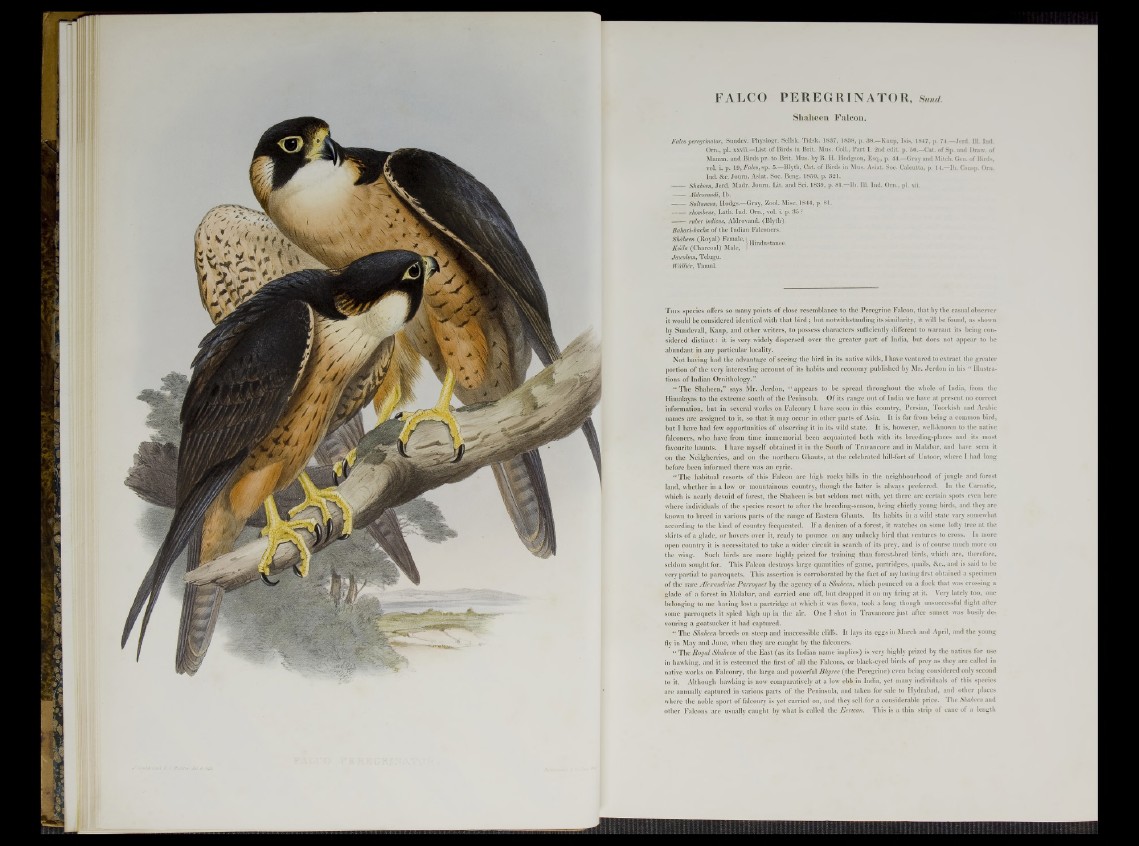
FALCO PEREGRIN ATOR, Sund.
Shaheen Falcon.
Falco peregrinator, Sundev. Physiogr. Sellsk. Tidsk. 1837, 1838, p. 38.—Kaup, Isis, 1847, p. 74.—Jerd. 111. Ind.
Orn., pi. xxvii.—List of Birds in Brit. Mus. Coll., Part I. 2nd edit. p. 50.—Cat. of Sp. and Draw, of
Mamm. and Birds pr. to Brit. Mus. by B. H. Hodgson, Esq., p. 44.—Gray and Mitch. Gen. of Birds,
vol. i. p. 19, Falco, sp. 5.—Blytk, Cat. of Birds in Mus. Asiat. Soc. Calcutta, p. 14.—lb. Consp. Orn.
Ind. &c. Joum. Asiat. Soc. Beng. 1850, p. 321.
¡¿ g i g Shaheen, Jerd. Madr. Joum. Lit. and Sci. 1839, p. 81.—lb. 111. Ind. Orn., pi. xii.
—— Aldrovandi, lb.
— — Sultaneus, Hodgs.—Gray,.Zool. Misc. 1844, p. 81.
—^Mrhombeus, Lath. Ind. Orn., vol. i. p. 35 ?
ruber indicus, Aldrovand. (Blyth).
Bahari-bacha of the Indian Falconers.
SMheen (Royal) Female, i IT. , \ , > rlindustanee. Koela (Charcoal) Male, J “
Jawolum, Telugu.
W&llilr, Tamul.
This species offers so many points of close resemblance to the Peregrine Falcon, that by the casual observer
it would be considered identical with that bird; but notwithstanding its similarity, it will be found, as shown
by Sundevall, Kaup, and other writers, to possess characters sufficiently different to warraut its being considered
distinct: it is very widely dispersed over the greater part of India, but does not appear to be
abundant in any particular locality.
Not having had the advantage of seeing the bird in its native wilds, I have ventured to extract the greater
portion of the very interesting account of its habits and economy published by Mr. Jerdon in his “ Illustrations
of Indian Ornithology. ”
“ The Shaheen,” says Mr. Jerdon, “ appears to be spread throughout the whole of India, from the
Himalayas to the extreme south of the Peninsula. Of its range out of India we have at present no correct
information, but in several works on Falconry I have seen in this country, Persian, Toorkish and Arabic
names are assigned to it, so that it may occur in other parts of Asia. It is far from being a common bird,
but I have had few opportunities of observing it in its wild state. It is, however, well-known to the native
falconers, who have from time immemorial been acquainted both with its breeding-places and its most
favourite haunts. I have myself obtained it in the South of Travancore and in Malabar, and have seen it
on the Neilgherries, and on the northern Ghauts, at the celebrated hill-fort of Untoor, where I had long
before been informed there was an eyrie.
“ The habitual resorts of this Falcon are high rocky hills in the neighbourhood of jungle and forest
land, whether in a low or mountainous country, though the latter is always preferred. In the Carnatic,
which is nearly devoid of forest, the Shaheen is but seldom met with, yet there are certain spots even here
where individuals of the species resort to after the breeding-season, being chiefly young birds, and they are
known to breed in various parts of the range of Eastern Ghauts. Its habits in a wild state vary somewhat
according to the kind of country frequented. If a denizen of a forest, it watches on some lofty tree at the
skirts of a glade, or hovers over it, ready to pounce on any unlucky bird that ventures to cross. In more
open country it is necessitated to take a wider circuit in search of its prey, and is of course much more on
the wing. Such birds are more highly prized for training than forest-bred birds, which are, therefore,
seldom sought for. This Falcon destroys large quantities of game, partridges, quails, &c., and is said to be
very partial to parroquets. This assertion is corroborated by the fact of my having first obtained a specimen
of the rare Alexandrine Panoquet by the agency of a Shaheen, which pounced on a flock that was crossing a
glade of a forest in Malabar, and carried one off, but dropped it on my firing at it. Very lately too, one
belonging to me having lost a partridge at which it was flown, took a long though unsuccessful flight after
some parroquets it spied high up in the air. One I shot in Travancore just after sunset was busily devouring
a goatsucker it had captured.
“ The Shaheen breeds on steep and inaccessible cliffs. It lays its eggs in March and April, and the young
fly in May and June, when they are caught by the falconers.
“ The Royal Shaheen of the East (as its Indian name implies) is very highly prized by the natives for use
in hawking, and it is esteemed the first of all the Falcons, or black-eyed birds of prey as they are called in
native works on Falcoury, the large and powerful Bhyree (the Peregrine) even being considered only second
to it. Although hawking is now comparatively at a low ebb in India, yet many individuals of this species
are annually captured in various parts of the Peninsula, and taken for sale to Hydrabad, and other places
where the noble sport of falconry is yet carried on, and they sell for a considerable price. The Shaheen and
other Falcons are usually caught by what is called the Eerwan. This is a thin strip of cane of a length